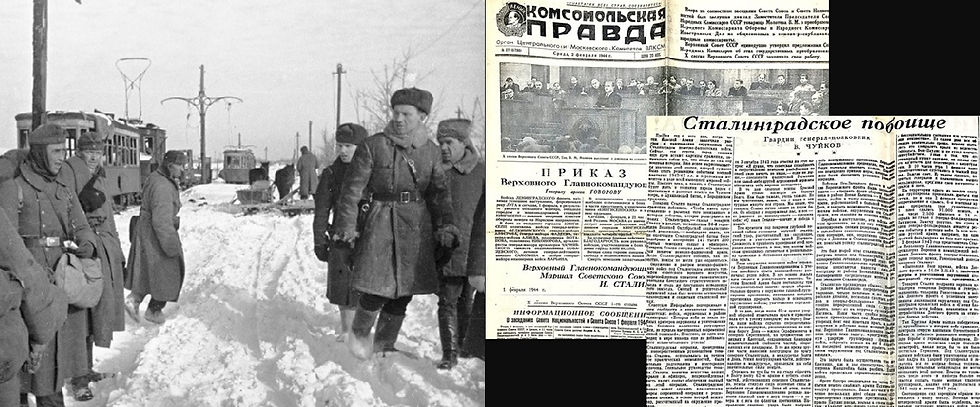
Pictured: Lieutenant-General V. I. Chuikov inspecting German soldiers; Komsomolskaya Pravda newspaper dated 2 February 1944 featuring an article on the first anniversary of the final German surrender on the Volga by 8th Guards Colonel-General V. I. Chuikov titled “Stalingrad Massacre” (Stalingradskoye Poboishche).
Seventy-nine years ago, the massive Battle for Stalingrad came to a close with the German surrender. The encircled Germans were squeezed into two pockets—the southern pocket was surrendered by Field Marshal Paulus on 31 January 1943. The northern pocket, where Lieutenant-General Chuikov and his 62nd Army were positioned, continued fighting until 2 February, when they also surrendered. Vasily Ivanovich described the miserable shape of the German soldiers on that final day—they were a pitiful shadow of their former selves, the once victorious 6th Army. Years later, Marshal Chuikov shared his memories about the event in his book titled From Stalingrad to Berlin:
“After the liquidation of the southern group of fascist German troops, the northern group still continued to resist, although it was clear that its complete liquidation was a matter of several hours.
On the morning of 2 February 1943, (Kuzma Akimovich) Gurov and I arrived at our observation post, which was located in the ruins of the factory office of the Krasny Oktyabr (Red October) plant. Immediately nearby were the observation posts of the division commanders Lyudnikov, Sokolov, and Gorishny. The last blow of the 62nd Army was inflicted on the Traktorny and Barrikady factories and their villages. The divisions of Gorishny, Sokolov, Lyudnikov, Guryev, Rodimtsev, and Shtrigol's brigade took part in the offensive. At the same time, parts of neighboring armies attacked the enemy's northern grouping from the west and north-west. The offensive began at 12 noon.
Artillery preparation was short: they fired only at direct fire and at visible targets. We clearly saw how the Nazis rushed about among the ruins. Immediately, the attack of our rifle units and tanks began. The surviving Nazis did not accept the last attack. They raised their hands. They had white rags on their bayonets.
We were led by hundreds and thousands of prisoners. They went to the Volga and beyond the Volga, to which they made their way for about six months. All the soldiers and non-commissioned officers were severely emaciated, insects infested their clothes. They were dressed so badly that it was scary to look at them: despite the 30-degree frost, some were barefoot. But the German officers, as the cavalrymen say, were in a full body. Their pockets were stuffed with sausage and other food, apparently left after the distribution of the ‘meager ration.’
At the last observation post of the army, in the ruined factory office of ‘Red October,’ the entire Military Council, the commanders of divisions and some regiments, gathered. They joyfully congratulated each other on the victory [and] remembered those who did not live to see this day.
Hitler, who had promised back in November 1942 to release the encircled troops, was forced to officially declare the disaster and declare three days of mourning.”
